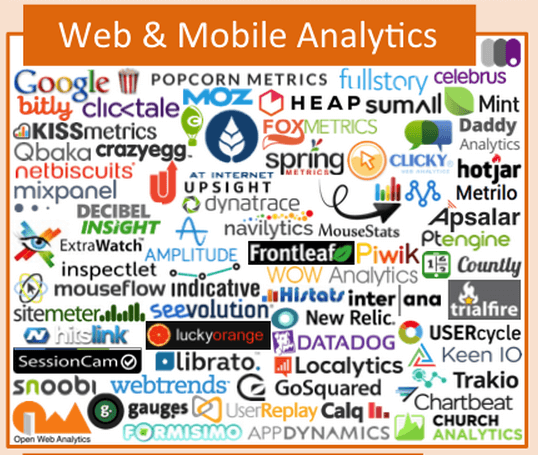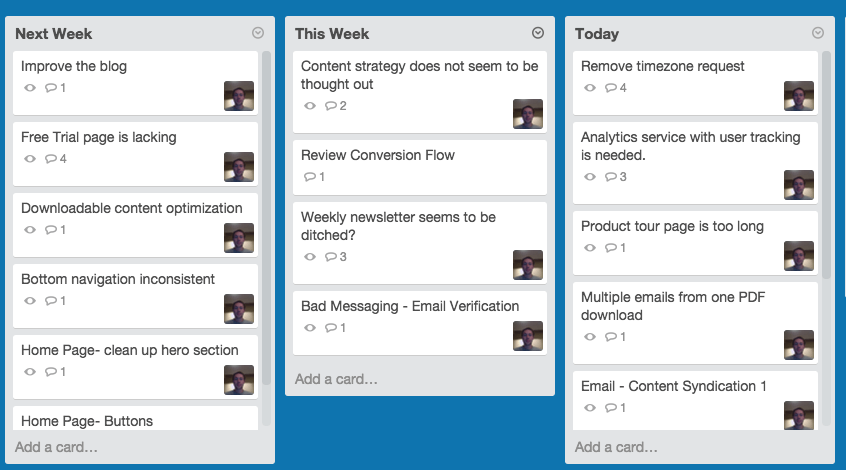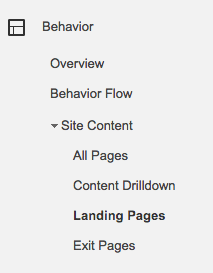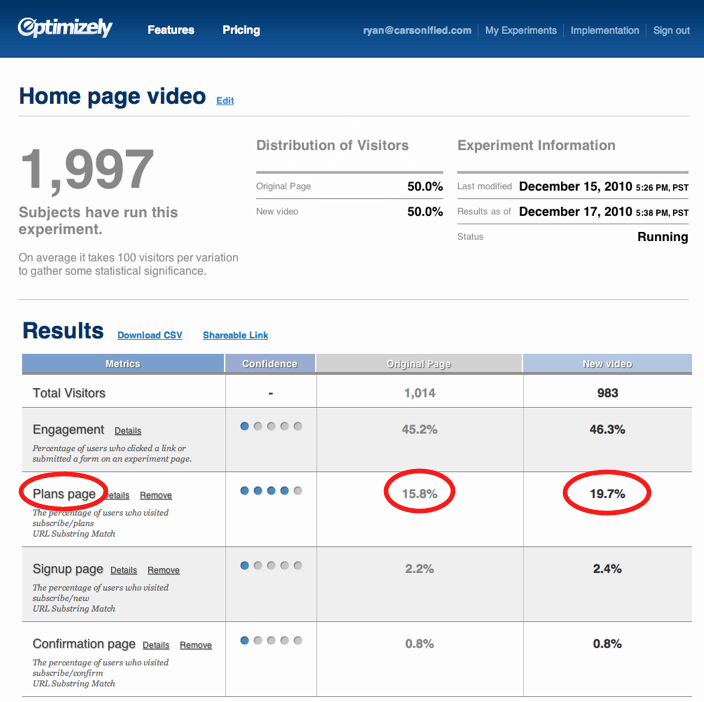Conversion rate optimization (CRO) is the practice of rendering an existing property, in our case usually websites and landing pages, to experiment with different ways to convert more visitors into taking a desired action.
The questions most people have on CRO are:
- Where to begin?
- How do I track the data?
- How do I setup an A/B test?
- When do I know if the test is conclusive?
- Will I break my site?
- What happens if the test fails and we lose money?
There’s an unlimited amount of content out there on CRO case-studies, expert tips and more, but we’re going to dive into the nitty-gritty tactical “how-to’s” so you can overcome your inner CRO battles and start optimizing your website today.
The CRO Mindset
Most of the time, when we’re not receiving the amount of sales or opt-ins that we want, we think in terms of doubling-down on acquisition: more ads, more SEO, more PR, you name it. While this can be a solution, it’s not the most efficient route to take.
Instead, you should think in terms of getting more out what you already have. That’s the CRO mindset. When everyone else is schlepping for more traffic and dumping more budget into their campaigns, you can attack the angle by converting more visitors into users or paying customers.
Here are some quick things you need to do to get into the right mindset.
- Understand failing is part of the game: As a CRO export I know this all too well, I have had 100’s, maybe even 1000’s of tests fail. The more you fail the faster you will succeed.
- Be open minded and be bold: CRO is all about putting your opinions aside and following the data. Many times the test you think that will double your conversion will end up cutting it in half, while the test you think will kill conversions, actually triples them. On top of this you need to try big audacious tests from time to time, don’t be afraid to push the boundaries, be bold.
- Let it go: It is normal to become focused in on one item on a page which we think will make conversions increase. Some people get focused on their headline text for months and never see results. Just let it go, like a Frozen song, and move on to more testing options.
Start with a Plan
Making sure you don’t test just to test. Before we get into the tactics, it should be stated upfront that testing without an idea of how or why it will affect conversions probably isn’t a good strategy. Before you setup a test or get into the internal debates about what will or won’t work, you should create a hypothesis backlog.
A hypothesis backlog is quite simply a way for you and your team to create an idea to test which you think will improve a particular part of your site. The key here isn’t really to focus on prioritization or how you store ideas, it’s just a way to get ideas into the backlog and ensure tests will always be occurring so you can ensure you have a constant feedback and optimization loop running smoothly.
Our team uses Trello to organize our hypothesis’ and manage their flow to being staged, launched and completed.
Ok, our first tactic. Collecting data
When it comes to gathering quantitative data about your customers and site visitors, you need to ensure you have the proper analytics in place. This means having Google Analytics with KISSMetrics or Mixpanel setup to ensure you’re tracking your site traffic on a macro- and micro-level. There are many other analytics tools out there, like too many.

KISSMetrics and MixPanel allow you to track people and events. People tracking is important because it allows you to see exactly who is doing what, and events are necessary because it allows you to build out a marketing funnel and see what actions people are taking across your site.
Having the proper analytics in place cannot be understated; do this right away! For detailed information on setting up analytics, check out these resources:
- How to Setup Google Analytics
- Install KISSMetrics & Getting Started With KISSMetrics
- Mixpanel’s Developer Documentation & Tracking Your First Event
Here are some quick basics though. Analytics services typically use an events based system with properties. The events are actions, and properties are the context of that action.
So if we used an example it may look like this:
Tony is walking his dog, he has a golden retriever who is 10 years old, male and eats kibbles and bits.
If I made this an analytics event, the event may be “Walked animal” with the following properties.
Animal type: Dog
Breed: Golden Retriver
Animal Age: 10
Animal preferred food: Kibbles and Bits
Walker age: Unknown
Collecting Insights
While having the right data and tracking the most important metrics is extremely valuable, talking to your customers and collecting qualitative feedback is equally important. Some tools you should look into are:
- Qualaroo
- SurveyMonkey or Wufoo
- UserTesting
- CrazyEgg
- …and talking to your customers!
These tools and processes should be used to unlock insights from your customers, helping your form test hypotheses.
For example, if you’re seeing a drop-off at your checkout page but cannot figure out why, you should look to see where your customers are clicking by using CrazyEgg and you can use UserTesting to see and hear what visitors are doing. In addition, talking to customers will enable you to understand why people are and aren’t taking the desired actions on your site.
What is an A/B test and How Can You Run One?
An A/B test is an experiment with one variable in each test. This allows you to make one change, send a random set of visitors to each page in the test, and see which one affects conversions.
Running A/B tests
There are really only two tools you need to know about – Optimizely & VWO. Each of these tools perform the most basic functions of setting up, managing and reporting on A/B test, but each of course has slightly different features. At McGaw.io, we prefer Optimizely over VWO due to the product functionality, quality support team and UX. We also are friends with a bunch of folks there :)
Using VWO and Optimizely is fairly straight-forward to setup a test, but these tools have a ton of different features which allow you to create more granular tests.
We recommend watching Getting Started With Optimizely or looking into this resource on setting up and using VWO.
In essence, you just apply one snippet of code on your site and Optimizely or VWO begin collecting data.
<script src=”//cdn.optimizely.com/js/1488356457.js”></script>
Then you can run any A/B test imaginable, most of which you won’t even need a developer for. Better yet, Optimizely’s support team is full of magnificent engineers who can help you setup tests when you’re stuck.
What Should You Test First?
Once you’ve developed a backlog of test experiments, it’s time to start executing on those ideas. Your first tests should be on the page where you generate the most traffic. This is important because not only will you learn the quickest, but it will also have the largest impact on conversions. You can find your most highly trafficked pages by going into your Google Analytics account and checking Behavior>Site Content>Landing Pages or Behavior>All Pages.
If you’re an e-commerce site or at least sell products/services directly on your site, we highly recommend that you should optimize your check out and pricing pages as well, even if they’re not the most highly trafficked.
The reason?
Those visitors are further down your funnel and have buyer intent. Always test where the money is. Every site (and I mean every site) has leaky patches in their funnel that they can fill in.
Some things to keep in mind when setting up tests: always look to improve the clarity of your messaging, minimize any unnecessary friction points such as long form fields or awkward layouts, and ensure the CTAs are relevant and persuasive…You would be amazed how removing phone number from a form can increase conversions.
Should You Focus on Big or Small Tests?
Conversion rate optimization comes in all different shapes and sizes; sometimes a simple button color change or removing the navigation links in the footer of a landing page will improve conversions; other times an entire site overhaul is required in order to get the biggest lift in conversions. With that being said, where should you focus first?
The truthful answer is, there is no correct answer. The more helpful answer, however, is if your landing page or website is performing terrible and below every benchmark conversion study you’ve ever found, then minor tweaks will likely not help at all.
If your site or landing page is performing on-par with others in your industry or based on your offer, then focusing on the messaging, structure and CTAs is a good bet.
Start Small
Assuming your site or page is converting at an average-ish or above average rate, you should be looking for areas where you can apply minor tweaks that you can test quickly.
The reason for this is twofold: one, it allows you to get up-to-speed on CRO in a risk-averse way, and it allows you to see the power of a small change and how it can have a major impact on conversions. When looking for ways to optimize your existing web property, you should have one core theme in mind: eliminate distractions. Distractions could be anything that takes your visitor’s attention away from the main CTA, such as:
- Navigation links at the header and footer of the page (especially landing pages)
- Overwhelming amount of CTAs (usually anything over 1-2 CTAs decreases conversions)
- Unnecessary copy and images
Clutter and offering more options than needed to your visitors actually decreases conversions. Often times in CRO, like most things, less is more.
When Should You Completely Overhaul Your Designs?
As we noted above, sometimes making small optimizations won’t lead to much improvement if your product, landing page, site, and so forth are sub-par to begin with. If that’s the case, then you don’t need to optimize your existing materials, you need to completely overhaul it.
While the step-by-step of overhauling your website is out of the scope of this particular blog post, I’d start by looking into articles such as this one, this one and this one. In short, those posts among many others, can give to a glimpse into the high-level structure of what a website built for conversions show (and shouldn’t have).
Focus on the basic fundamentals of your website first, then you can dig into the details to uncover conversion opportunities.
Measuring Success: Calling Winners and Losers
One of the biggest mistakes people make early on in their CRO careers is that they call tests too early. They’ll setup an A/B test, and after one day and 10 total conversions they’ll choose B because it’s ahead by 3 conversions over A. Don’t.Do.That.
When you begin an experiment, you need at least 100 conversions to achieve statistical significance on both tests to even consider calling it, and 200 on each test is even more statistically significant. Since not all of us have thousands of visitors per day it may not be practical to generate several hundred conversions for each test, so setting a goal of 100 conversions per test is a respectable number.
Optimizely allows you to track the progress of your A/B tests through their confidence rating feature which is a reliable way to measure the statistical significance of an A/B test.
Measuring success isn’t just about conversions, however. While it’s certainly the main metric to look for, there’s other things such as engagement (i.e. time on site), pages visited, etc.
If you’re solely looking to build your customer base and have them use your free product, then measuring success by usage and engagement is perfectly acceptable. The goal in any optimization experiment should always be to make things better. Better for your users and customers, and better for your business.
Takeaway
Conversion rate optimization sounds like an intimidating practice that only experts can take advantage of, but the truth is that if you just invest some time in learning the basics and actually apply your learnings, even on a small scale, you’ll be leap and bounds ahead of most people and companies. If you’re focused on generating traffic to your website at all, especially through paid channels, you are leaving money on the table if you’re not taking conversion and engagement metrics seriously. That’s a fact that holds true with every business and website.
To learn more about CRO, we highly recommend reading these blogs and subscribing to their newsletters:



Is it rude to suggest our tool too? Decibel Insight (lesser known as we are more recently established) is a more comprehensive behavioural insights tool for CRO than others on the market. We would rather you decide though – so feel free to get in contact and take a free trial.
One of the nice blog i have seen and i got an useful information from this blog. Keep updating this.
Conversion Rate Optimization Experts in USA
CRO is beneficial for a website, and these tests are helpful for the website and for you to understand what is going wrong and what is wrong in the funnel. I wanted to know what a business should do if they don’t know how to test CRO? should they hire an agency to help them?